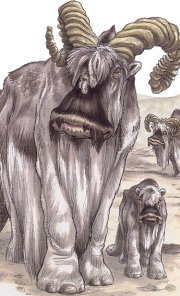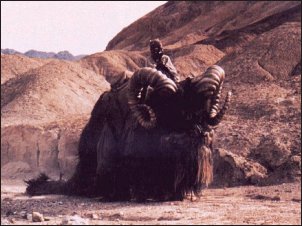 |
| BANTHA |
| [There are two banthas down there but I don't see any...wait, there's sandpeople alright...] |
| 19 AE | Bantha 01 |
| Origin: Tatooine Habitat: Various Type: Woolly mammal Diet: Herbivorous |
| Links: Bantha tracks newsletter |
| For A New Hope, the crew dressed an elephant up to play the bantha of Tatooine |
| Just how the shaggy banthas managed to survive on the arid desert world of Tatooine was a mystery, though the hardy beasts of burden were certainly welcomed there. Banthas were not giant creatures - they stood at about 2 meters tall - and thus could be ridden easily. On Tatooine, Tusken Raiders domesticated many banthas to use them as mounts. The woolly creatures were able to cross the deserts and canyons of Tatooine with ease. Banthas were also used in cities and settlements across the planet as pack animals. Another use for the bantha came from its hide and its milk; bantha meat and milk were considered rare food items, while jackets, boots and other clothing could be made from a bantha's hide. As banthas were found throughout the galaxy, their physiology and behaviour changed depending on their environment. While usually docile, there were a number of feral banthas that proved to be very dangerous. While all banthas were herbivores, their sharp horns and trampling feet posed a danger if the beasts became startled, agitated or if their young are threatened. As they travelled in herds, such rampages were all the more dangerous. Bantha herds consisted of up to twenty-five individuals, led by the oldest, strongest female. A herd which grew too large split, with the second oldest and strongest female leading the new herd. The average bantha could live more than eighty years; the banthas of Tatooine were known to form deep bonds with the Tusken Raiders, and as they could well outlive their riders, they would often commit suicide if their Tusken owner were to die. Banthas which died naturally were placed in vast graveyards, which held a ceremonial reverence with other banthas. These graveyards were defended fiercely by the beasts. |
 |
 |